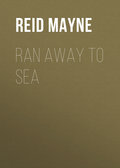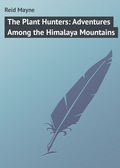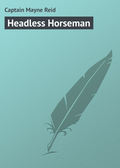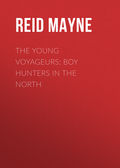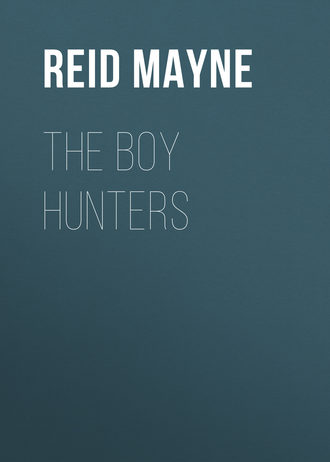
Майн Рид
The Boy Hunters
Chapter Nine.
The Indian Mother and Caïman
“There is, perhaps, no part of America where the alligators grow to a greater size, and are more fierce in their nature, than upon the Magdalena, and other great rivers that run into it. These rivers flow through a low country within the tropics; their climate is of the hottest kind, and consequently most suitable to the development of the great reptiles. The indolent character of the natives, too – half-Indian, half-Spanish – prevents them from attacking and destroying these creatures with that energy that is exhibited by the inhabitants of our own country. The consequence is, that the animals in their turn are less afraid of man, and often make him their prey. The alligators of the Magdalena – or ‘caïmans,’ as they are there called – frequently destroy natives, who by any unlucky accident may have fallen into the waters frequented by them. Not unfrequently the boatmen (bogadores) who navigate the river Magdalena in their bogas, or flat boats, drop overboard, and become the prey of the caïmans, as sailors on the ocean do of sharks. These boatmen sometimes carry rifles, for the purpose of shooting the caïmans; yet there are but few destroyed in this way, as the bogadores are too much occupied in navigating their crafts; and, moreover, it is a very difficult thing to kill an alligator by a shot. You can only do it by sending the bullet into his eye, as the rest of his body is impervious even to a musket-ball. Of course, to hit one in the eye requires a sure aim, and a good opportunity when the animal is lying still upon the bank or on the water. When out of the water a caïman may be shot in the soft elastic skin behind the fore-shoulder; but this is a very uncertain method of killing one; and several shots fired into his body at this part will often fail to prove fatal. Sometimes the natives of the Magdalena catch the caïmans with lassos; and after dragging them upon the bank, despatch them with axes and spears. Notwithstanding this, the caïmans swarm upon these rivers, and are seldom molested by the inhabitants, except at intervals when some horrid tragedy happens – when some unfortunate victim has been snatched off by them, torn in pieces, and devoured. When this occurs, the people, sympathising with the distress of their neighbour, awake from their habitual apathy, collect together, and destroy great numbers of these hideous reptiles. The story I have promised you illustrates an affair of this kind.
“A vaquero (cattle-herd) lived upon the Magdalena, some miles above the city of New Carthagena. His palm-thatched rancho, or cottage, stood at a little distance from the bank of the river, at a point where it was much infested by caïmans – as the country around was wild and thinly settled. The vaquero had a wife and one child, a daughter – who was about six or seven years old; and being a pretty little girl, and the only one, she was of course very dear to both the parents.
“The vaquero was often absent from home – his business with his cattle carrying him to a great distance into the woods. But his wife thought nothing of being thus left alone. She was an Indian woman, and used to dangers, such as would terrify the females that live in great cities.
“One day when her husband was absent as usual, looking after his cattle, this woman took some clothes to the river bank for the purpose of washing them. The river was the only water near the rancho; and by thus carrying the clothes to it, she saved herself the trouble of fetching the water a good way; besides, there was a broad, smooth stone by the bank, where she was accustomed to beat out her linen. Her little daughter accompanied her, carrying one of the bundles.
“On reaching the spot, the woman filled her vessels with water, and commenced her work; while the child, having nothing else to occupy her, began to gather some ripe guavas, plucking them from a tree that grew out from the bank, and hung somewhat over the river. While the Indian mother was thus engaged, she was startled by a wild scream and a plunge, that were heard almost together; and, on looking round, she saw her child just sinking in the water. At the same time, she beheld a hideous object – a huge caïman – making for the spot! Filled with horror, the woman dropped her linen, and rushed out upon the bank. She did not hesitate a moment, but plunged into the river, which buried her to the neck. At that moment the child rose again to the surface. The mother seized her by the arms; and was about raising her out of the water, when the caïman swept forward open-mouthed, caught the limbs of the little girl, and with one crunch of his powerful jaws severed them from the body! The little girl screamed again; but it was her last scream. When the mother struggled to the shore, and laid the mutilated body upon the bank, the child had ceased to breathe.
“For some moments sat the wretched mother, gazing upon the still quivering remains. At intervals, she stooped down and kissed the pale, withering lips. She did not weep. I have said she was an Indian. They do not act as whites do; but, anyhow, her anguish was too keen to allow her tears to flow. She did not scream or call for help. It could be of no use now. It was too late. She knew there was no one near – no one within miles of her. When she raised her eyes from the mangled corpse, it was only to rest them upon the black water, and there, under the shadow of the guava bushes, swam the hideous reptile, to and fro. He had swallowed the morsel, and was eagerly watching for more.
“The countenance of the woman betrayed a mingled expression of agony and vengeance. All at once a thought seemed to strike her – a sudden resolve. She rose; and, casting a look first at the dead body, and then upon the caïman, hurried off to the house. In a few minutes she came back, bringing with her a long spear. It was the hunting-spear of her husband – often used by him in his encounters with the Brazilian tiger, and other fierce creatures of the forest. She brought also several other articles – a lasso, some cords of the pita, and a couple of knives.
“On arriving at the bank, she looked anxiously over. The caïman was still there; and she turned, and stood for a moment as if considering what to do. Her mind was soon made up; and, bending forward, she thrust the spear lengthwise through what remained of her child’s body! It was a fearful act, but the feeling of revenge was strong within her. She next caught the blade of the spear – now red with blood – and placing the knives lengthwise – so that they might serve as barbs – tied them firmly upon it with the pita cord. Close up to these she pushed the mangled body, and then looped the lasso tightly to the shaft of the spear. The other end she made fast to the trunk of a guava tree – for she well knew that her own strength would avail but little against such a monster as the caïman.
“When all was ready she poised the shaft, and flung spear, body, and all, into the water. Then taking the rope in her hand, she crouched behind the bushes to await the result.
“She had not long to wait. The reptile, thirsting for more blood, saw the tempting morsel; and, darting forward, seized it in his huge jaws, crushing it in the act. The woman remained motionless, biding her time.
“The caïmans do not masticate their food. Their teeth are not formed for that. They are only made for seizing; and the tongue – which they cannot extend forward – only serves to assist them in swallowing. In a few moments the body had disappeared down the capacious throat of the monster. Seeing this, the woman suddenly sprang to her feet, and dragged violently upon the rope, and the next moment a wild scream announced that she had succeeded in her intentions. The barbed blades had taken hold, and the caïman was secured!
“Finding himself thus caught, the huge reptile dived to the bottom, then rose again, bellowing loudly, and lashing the water into foam, the blood all the while running from his jaws and nostrils. At intervals, he would rush from point to point – until suddenly checked by the strong raw-hide lasso – making the tree shake with his great strength; and this he did for a long while. His struggles at length grew fainter, and more feeble, and he lay motionless in the water. Throughout all this scene the mother sat upon the bank of the river, at times in deep silence and dejected, while at intervals her face would light up with a vengeful expression as she cast her eyes upon the monster that had robbed her of her child.
“At length the gallop of a horse roused her from her reverie. She looked around. It was her husband!
“The melancholy tale was soon told; and shortly after was carried to those that dwelt nearest them. The grief was general; and the sympathy that followed caused a general rising throughout the neighbourhood; and for several days afterwards a war of extermination was waged against the caïmans.
“This, brothers,” said Lucien, “is a true narrative; and, in fact, it is only a year or two since the painful incident occurred.”
“And a painful incident it was,” cried Basil, with some excitement. “Thunder! it makes one hate those monsters so I feel like having a shot at one this very moment; besides I want a tooth for a powder-charger;” and as he said this, he took up his rifle, and stepped out to the water’s edge. None of the alligators appeared to be within range at the moment, though dozens of them were seen moving about on the bayou.
“Hold, brother!” shouted François. “Have patience a little, and I’ll bring them near enough. Place yourself in ambush, while I call them.”
Now one of François’ accomplishments was an unusual talent for mimicry. He could imitate everything, from the crowing of a cock to the bellowing of a bull, and so naturally as to deceive even the animals themselves. Running down towards the bank, he crouched behind some yucca-bushes, and commenced whining and barking like a young puppy. Basil also concealed himself among the bushes.
In a few seconds, several alligators were seen swimming over the bayou, coming from all sides at once. They were not long in reaching the bank where François lay concealed, and foremost of all a large male, throwing up his snout, crawled out of the water. He was calculating, no doubt, on making a meal of something; but was doomed to disappointment, and worse than that, for the sharp crack of Basil’s rifle rang upon the air, and the hideous reptile rolled over in the mud; and, after sprawling about for a while, lay motionless. He was quite dead, as the well-aimed rifle had sent a bullet right into his eye.
Basil and François now showed themselves – as they did not care to waste their ammunition by shooting any more – and the rest of the alligators, seeing them, swam off faster than they had come. By the aid of Lucien’s hatchet, the largest teeth were knocked out of the jaws of the one that had been killed; and the horrid carcass was left where it lay, to feed the wolves and vultures, or anything else that chose to make a meal of it.
After cooking a pot of coffee and a venison-steak for supper, our adventurers spread their buffalo-robes within the tent, and went to rest for the night.
Next morning they were astir by daybreak; and after breakfasting heartily, they saddled their horses, and resumed their journey.
Chapter Ten.
The Food of the Silkworm
After leaving Bayou Crocodile, our young hunters travelled due west, over the prairies of Opelousas. They did not expect to fall in with buffalo on these great meadows. No. The bison had long since forsaken the pastures of Opelousas, and gone far westward. In his place thousands of long horned cattle roamed over these plains; but these, although wild enough, belonged to owners, and were all marked and tended by mounted herdsmen. There were white settlements upon the prairies of Opelousas, but our adventurers did not go out of their way to visit them. Their purpose was to get far beyond; and they did not wish to lose time.
They crossed numerous bayous and rivers, generally running southward into the Mexican Gulf. The shallow ones they forded, while those that were too deep for fording, they swam over upon their horses. They thought nothing of that – for their horses, as well as the mule Jeanette and the dog Marengo, were all trained to swim like fishes.
After many days’ travel they reached the banks of the river Sabine, which divides Louisiana from Texas, then a part of the Mexican territory. The face of the country was here very different from most of that they had passed over. It was more hilly and upland; and the vegetation had altogether changed. The great dark cypress had disappeared, and pines were more abundant. The forests were lighter and more open.
There was a freshet in the Sabine; but they swam across it, as they had done other rivers, and halted to encamp upon its western bank. It was still only a little after noon, but as they had wet their baggage in crossing, they resolved to remain by the river for the rest of the day. They made their camp in an open space in the midst of a grove of low trees. There were many open spaces, for the trees stood wide apart, and the grove looked very much like a deserted orchard. Here and there a tall magnolia raised its cone-shaped summit high above the rest, and a huge trunk of one of these, without leaves or branches, appeared at some distance, standing like an old ruined tower.
The ground was covered with flowers of many kinds. There were blue lupins and golden helianthi. There were malvas and purple monardas, and flowers of the cotton-rose, five inches in diameter. There were blossoms of vines, and creeping plants, that twined around the trees, or stretched in festoons from one to another – the cane-vine with its white clusters, and the raccoon grape, whose sweet odours perfumed the air; but by far the most showy were the large blossoms of the bignonia, that covered the festoons with their trumpet-shaped corollas, exhibiting broad surfaces of bright scarlet.
In the midst of these flowers our hunters pitched camp, picketing their animals, and putting up their tent as usual.
The sun was shining brightly, and they proceeded to spread their wet robes and blankets.
“It strikes me,” said Lucien, after they had completed their arrangements for camping, “that we have halted on the site of an old Indian town.”
“Why do you think so?” asked Basil.
“Why, I notice these heaps of rubbish here that are covered with weeds and briars. They are Indian graves, or piles of decayed logs where houses once stood. I can tell from the trees, too. Look around! do you see anything peculiar in these trees?”
“Nothing,” replied Basil and François together. “Nothing, except that they are mostly small and low.”
“Do you not observe anything odd in their species?”
“No,” said Basil. “I think I have seen them all before. There are mulberry-trees, and black walnuts, and Chicasaw plums, and pawpaws, and Osage orange, and shell-bark hickories, and pecans, and honey-locusts. I see no others except vines, and those great magnolias. I have seen all these trees before.”
“Yes,” returned Lucien, “but have you ever observed them all growing together in this way?”
“Ah! that is a different affair: I believe not.”
“Because it is from that fact,” continued Lucien, “that I am led to believe this spot was once the seat of an Indian settlement. These trees, or others that produced them, have been planted here, and by the Indians.”
“But, brother Luce,” interposed François, “I never heard that the Indians of these parts made such settlements as this must have been. These low woods extend down the river for miles. They must have had a large tract under cultivation.”
“I think,” replied Lucien, “the Indians who at present inhabit this region never planted these trees. It is more likely a settlement of the ancient nation of the Natchez.”
“The Natchez! Why, that is the name of a town on the Mississippi, but I did not know there were Indians of that name.”
“Neither are there now; but there once was a very extensive tribe so called who occupied the whole territory of Louisiana. It is said that, like the Mexicans and Peruvians, they had made some progress in civilisation, and knew how to weave cloth and cultivate the soil. They are now an extinct race.”
“How came that about?”
“No one can tell. Some of the old Spanish authors say that they were destroyed by Indians from South America. This story, however, is very absurd – as is, indeed, most of what has been written by these same old Spanish authors, whose books read more like the productions of children than of reasoning men. It is far more likely that the Natchez were conquered by the Creeks and Chicasaws, who came from the south-west of their country; and that the remnant of their tribe became blended with and lost among the conquerors. In my opinion, this is how they have come to be extinct. Why, then, should not this be one of their ancient settlements, and these trees the remains of their orchards, cultivated by them for their fruits and other uses?”
“But we make but little use of such trees,” remarked François.
“What’s that you say?” exclaimed Basil. “You, François, who every year eat such quantities of shell-bark nuts, and pecans, and red mulberries, too! – you who suck persimmons like a ’possum! – no use, eh?”
“Well, that’s true enough,” rejoined François, “but still we do not cultivate these trees for their fruits – we find them in the woods, growing naturally.”
“Because,” interrupted Lucien, “we have the advantage of the Indians. We understand commerce, and get other and better sorts of fruits from all parts of the world. We have cereals, too, such as wheat and rice, and many kinds which they had not; we can therefore do without these trees. With the Indians it was different. It is true they had the Indian corn or maize-plant (Zea maïz), but, like other people, they were fond of variety; and these trees afforded them that. The Indian nations who lived within the tropics had variety enough. In fact, no people without commerce could have been better off in regard to fruit-bearing plants and trees than the Aztecs, and other tribes of the South. The Natchez, however, and those in the temperate zone, had their trees and plants as well – such as those we see before us – and from these they drew both necessary food, and luxurious fruits and beverages. Indeed the early colonists did the same; and many settlers in remote places make use to this day of these spontaneous productions of Nature.”
“Would it not be interesting, Basil,” said François, appealing to his elder brother, “if Lucien would give a botanical description of all these trees, and tell us their uses? He knows all that.”
“Yes,” replied Basil, “I should like to hear it.”
“That I shall do with pleasure,” said Lucien. “Not, however, a botanical description, according to the sense of the Linnean school, as that would weary you soon enough, without adding much to your stock of information. I shall only state what I know of their properties and uses; and I may remark that there is not a tree or plant that is not intended for some use in the economy of Nature. If botanists had spent their time in trying to discover these uses, instead of wasting it in idle classifications, mankind would have been more enriched by their labours.
“Let us begin, then, with the mulberry-tree, as there are many of them growing around. Were I to tell you all about this valuable tree, I should occupy a day or more. I shall only state those facts about it that are most interesting.
“The mulberry-trees form the genus morus– for this was the name by which they were known to the ancient Greeks. Of this genus there are several well-known species. No doubt there may be other species growing in wild countries, and yet unknown or undescribed by botanists; and this remark applies as well to other trees, for every day we hear of new varieties being discovered by enterprising explorers.
“First, then, comes the white mulberry (Morus alia). It is the most important species yet known. This you will readily admit when I tell you that from it comes all our silk – spun out of it by the silkworm (Bombyx mori). It is called white mulberry on account of the colour of its fruit, which, however, is not always white, but sometimes of a purple or black colour. Now it would be difficult to give an exact description of a white mulberry-tree; for, like the apple and pear trees, there are many varieties of it produced from the same seeds, and also by difference of soil and climate. It is a small tree, however, rarely growing over forty feet high, with thick leaves and numerous branches. The leaves are the most important part of it – for it is upon these the silkworms feed, spinning their fine threads out of the milky juice, which in its properties resembles the juice of the caoutchouc tree. It is true that the silkworm will feed upon the other species of mulberries, and also upon slippery elms, figs, lettuce, beets, endive, and many kinds of leaves besides; but the silk made from all these is of an inferior quality; and even the varieties of the white mulberry itself produce different qualities of this beautiful material.
“This tree has other uses. Its wood is compact and heavy, weighing forty-four pounds to the cubic foot. In France it is much used in turnery; and wine-casks are made from it, as it gives to white wines an agreeable flavour of violets. Vine-props and fences are made from its branches; and out of its bark – by a process which I have not time to describe – a cloth can be manufactured almost as fine as silk itself. The fruit of the white mulberry – where it grows in warm climates – is very good to eat, and makes an excellent syrup.
“The white mulberry, it is supposed, first came from China, where it is still found growing wild; and the Chinese first cultivated it for feeding silkworms as early as 2700 years before the Christian era. The tree is now found in every civilised country, growing either as an ornament of the shrubbery, or for the manufacture of silk.
“The next species is the black mulberry (Morus nigra), so called on account of the colour of its fruit, which is of a dark purple, nearly black. This kind came originally from Persia, but is now, like the white mulberry, found in all civilised countries. It is cultivated more for ornament and shade than for feeding silkworms; though it is put to this use in some parts, especially in cold climates, where the other species does not thrive. They are easily distinguished from each other – the bark of the black being much rougher and darker. The wood of the latter is not so firm nor heavy as the white, but it is also durable, and is used in England for hoops, wheels, and ribs of small vessels. In Spain, Italy, and Persia, they prefer the leaves of the black for feeding the silkworm. They are also eaten by cattle, sheep, and goats. The roots when prepared are used as a vermifuge. The fruit has a pleasant aromatic taste; and is eaten both raw and in preserves, or mixed with cider makes an agreeable drink. The Greeks distil a clear weak brandy out of them; and in France they make a wine from these mulberries – which must be drunk while it is new, as it soon turns to vinegar. This fruit is good for fevers and rheumatisms; and it is much sought after by birds and all kinds of poultry, who devour it greedily.
“So much for the white and black mulberry-tree. We now come to the third species, the red (Morus rubra).
“That is the red before your face,” continued Lucien, pointing to the trees, which he had already designated. “It is so called from the fruit, which, as you know, are of a dark red colour, and resemble red raspberries more than anything in the world. Some of these trees, you see, are nearly seventy feet in height, though it usually does not reach so high. You notice the leaves. The are heart-shaped, many of them ten inches long, and nearly as broad as long. They are dark green and rough, and for feeding the silkworm quite useless where the white mulberry grows. They form a delightful shade, however; and this is one of the uses of this beautiful tree. The fruit, too, is, in my opinion – and I think François will agree with me – quite equal to the best raspberries. As for the wood, it is much used in the dockyards of the Southern states. It is of a pale lemon colour; and is considered more durable for trenails than any other – that of the locust excepted.
“The red mulberry, like the white and black species, runs into several varieties, differing considerably from each other.
“There is still a fourth species of this genus, called the paper mulberry (Morus papyrifera). This, however, has been separated by botanists into another genus; but it is worth a word here, as it is a very curious and valuable tree, or, rather, a large shrub, for it does not grow so tall as either of the other three. It is a native of China, Japan, and the islands of the Pacific Ocean; but, like the others, it is cultivated for ornament both in Europe and America. Its fruit, which is of a scarlet colour, is globe-shaped, and not oblong, as that of the true mulberries; and this is one reason why it has been separated into a genus by itself. Its leaves are of no use for silk-making, but they make excellent food for cattle; and as the tree grows rapidly, and carries such large bunches of leaves, some people have said that it would yield better than grass, and should be cultivated for pasture. I do not know whether this has been tried yet. The most interesting part of the paper mulberry is its bark, which is used in the manufacture of paper both in China and Japan. The beautiful India paper used for engravings is made from it, and so, too, is the fine white cloth worn by the natives of the Society Islands, and which so much astonished Europeans when they first saw it. It would be interesting to detail the process of manufacturing this cloth as well as the paper, but it would take up too much of our time at present.
“There is another genus of trees which resembles the mulberries very much. They are valuable for their wood, which produces a fine yellow dye, known by the name of ‘fustic-wood.’ The tree that produces the best of this dye is the Morus tinctoria, and grows in the West Indies and tropical America; but there is a species found in the southern United States, of an inferior kind, which produces the ‘bastard fustic’ of commerce.
“So much, then, for the mulberry-tree; but I fear, brothers, I have left but little time to describe the others.”
“Oh! plenty of time,” said Basil; “we have nothing else to do. We are better learning from you than rambling idly about; and upon my word, Luce, you make me begin to take an interest in botany.”
“Well, I am glad of that,” rejoined Lucien, “for I hold it to be a science productive of much good, not only on account of its utility in the arts and manufactures, but to the mind of the student himself; for, in my belief, it has a refining influence.”
And Lucien was about to continue his description of the trees, when a series of incidents occurred which put an end to the conversation, at least upon that subject.
These incidents are recorded in the chapter which follows.



